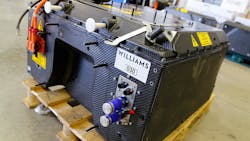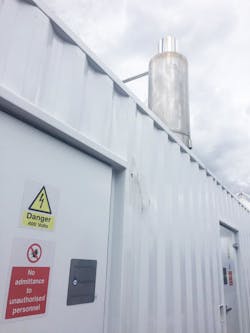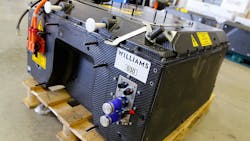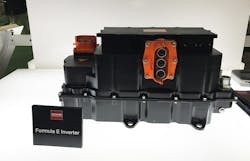Under the Hood of the EVs in the FIA Formula E Championship
In case you haven’t heard of it, there is an electric-vehicle street racing series called Formula E. The racing season runs from the fall through summer with a third, season-ending race in New York (this year on July 15). The goal of Formula E is to promote the concept of sustainability to reduce our footprint as much as possible while having a positive impact on both people and the planet. The race features 10 teams with 20 drivers and 40 electric racing cars, which are powered by lithium-ion batteries. They race at speeds up to 220 km/h.
Here are some of the most important technologies behind the Formula E race cars:
Generators: The generators that are used to charge the racing cars run on glycerine. This carbon-neutral fuel is safe, odorless, non-toxic, and water soluble. It also is an abundant byproduct of biodiesel production. A British company called Aquafuel Research Ltd. was commissioned to build the mobile generators that could be packed inside a shipping container and freighted to each race (Fig. 1). The generators are based on standard production diesel engines—a Cummins KTA50 to be precise—that have been adapted with Aquafuel’s patented technology to run on glycerine. The Aquafuel generators on site provide 42 kW of electricity per car.
1. The glycerine base that powers the generators can be made by salt-water algae where food crops won’t grow.
Battery: The battery is a sealed black box, meaning that no access or maintenance by the teams is allowed. For safety reasons, rather than changing batteries halfway through the race, the drivers change cars instead.
Williams Advanced Engineering has supplied the batteries (Fig. 2) since the race’s first season. It also was the first company to complete FIA (Federation International De L’Automobile) crash testing and has met UN transportation testing regulation 38.3 for the safe air transportation of lithium ion batteries. For Season 3, Williams Advanced Engineering has introduced an updated version of its 28kW.
2. The Formula E batteries built by Williams for Formula E use lithium-ion cells made by XALT Energy.
According to Paul McNamara, technical director at Williams Advanced Engineering, “We have made quite a range of small changes in three areas: the first one is the cooling system - with changes to make that more robust and make it easier for us to assemble and disassemble. We’ve also done a few things to improve the performance of the thermal interface materials and the details of how the cooling tubes link up with the cells and the bus bars.”
“The second area is the bus bars themselves,” he continues. “In the battery, we’ve got proper bus bars dealing with the quite high currents. In terms of building up the battery, those bus bars all have to be interconnected. They’ve got special joints in them so that we can disarm it and bring it down to beneath 50 V and allow us to disassemble it. Those joints have improved so they’re more resilient to vibration and the thermal displacement going into them has improved in the battery as well.” McNamara states, “And the final area has been in the detail design around supporting the cells, because the pack cells of the battery have to be supported and insulated from vibration and then connected into the bus bars. So, we’ve made quite a lot of detail changes to do that throughout. All of those things help us with making the batteries more reliable for the teams, but they also help us in extracting more power and help us to put in more power.”
Starting in the 2018 season, however, the battery packs will come from a new supplier. Actually, McLaren Applied Technologies, Lucid, and Sony will partner on the battery packs for Formula E with a contract of two seasons. The new battery technology will double the current capacity, enabling the drivers to complete a full race in a single car instead of charging or changing their vehicle mid-race.
The original FIA battery specifications included a 200-kg (441-lb.) cell-weight limit, a 200-kW peak power limit, and a maximum usable energy of 28 kWh. In revised specifications starting with Season 5, cell weight has been nudged to 250 kg (551 lbs.) and peak power rises to 250 kW (with usable energy very nearly doubled at 54 kWh).
Inverters: For the first season, an inverter was supplied by McLaren Applied Technologies. It was mounted above the battery behind the chassis’ roll hoop. This placement was due to a lack of space inside the casing around the eMotor. In this position, however, the inverter also was accessible and easy to cool.
As part of the Formula E roadmap, which allows manufacturers to develop new technologies, Season 2 opened the regulations to allow manufacturers to design and build their own powertrains. In season 3, silicon-carbide (SiC) technology is now being used in inverters. For example, Rohm Semiconductor partnered with the Venturi Formula E team to incorporate SiC Schottky Barrier Diodes (SBDs) in the inverter. Their goal was to enhance powertrain performance while increasing switching speeds and improving thermal efficiency (Fig. 3).
3. Rohm’s SiC Schottky diodes reduce the inverter weight by 2 kg and cooling components by 30% for this season of the Formula E.
With the Formula E’s success as a technology incubator, it’s clear that the transportation industry is already benefiting from technology adoption and development as well as new jobs. Upcoming seasons will increasingly highlight the potential for sustainability in EVs. Expect continuous efforts to reduce the energy footprint while removing barriers to EV adoption, such as EV infrastructure and the high costs and limited range of batteries.
About the Author
Maria Guerra
Power/Analog Editor
Maria Guerra is the Power/Analog Editor for Electronic Design. She is an Electrical Engineer with an MSEE from NYU Tandon School of Engineering. She has a very solid engineering background and extensive experience with technical documentation and writing. Before joining Electronic Design, she was an Electrical Engineer for Kellogg, Brown & Root Ltd (London. U.K.). During her years in the Oil and Gas Industry she was involved in a range of projects for both offshore and onshore designs. Her technical and soft skills bring a practical, hands-on approach to the Electronic Design team.




